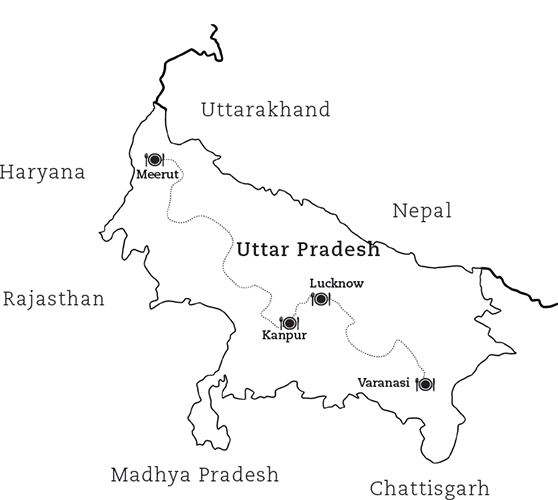UTTAR PRADESH

The state of Uttar Pradesh, or ‘UP’ as it is popularly called, has many #1 positions to its credit. It’s the most populous state in India, has the oldest continuously populated city in India (Benares/Varanasi), is home to India’s most famous monument (Taj Mahal), the largest crop of India’s favourite fruit (mango), and is also home to the best known Indian cuisine (Mughlai), thanks to the diversity of its population—be it by religion, cast, creed, socio-economic factors etc. UP also enjoys a vast range of cuisines, recipes, and dishes. Agriculture is still the largest occupation in UP.
Varanasi, located by the banks of the river Ganga, is famous for its milk products as there is an abundance of milk thanks to it being considered a holy offering for the multitude of Gods and their numerous temples. Highly popular among the wide range are items like Rabri, Mallaiyo, Dahi, Lassi, and Khoya. Sweets made from Khoya—a product produced by slowly cooking milk until all the water evaporates—are famous here. The khoya is mixed with dried fruits, nuts, flavouring, and sugar to make an endess variety of sweets like Barfi, Pedas, Laddoos, and Gulabjamun. In fact there is a full lane called Khoya Gali devoted to the production and sale of khoya. Another famous street, the Kachori Gali, once boasted of numerous shops offering the delicious deep-fried spicy snack filled with a stuffing of lentils, chickpea flour, and spices. The few left now offer kachoris along with a spicy vegetable or chickpea stew. It’s best followed by some piping hot, sinfully sweet Jalebis (deep-fried coils of dough soaked in sugar syrup). Many eateries in and around Varansai and also a majority of the population are vegetarian and many won’t even use onions and garlic in their cooking. A wide range of vegetables and lentils are cooked and usually eaten with wheat flatbreads in various forms forms including Rotis and Pooris. The range of spices used in cooking is also diverse and includes ginger, garlic, turmeric, asafoetida, chilli, cumin, and mustard. UP is also famous as the birthplace of Chaat, a collective term for street-side snacks including deep-fried spiced potato patties, deep-fried lentil doughnuts in a bed of yoghurt topped with sweet/sour chutneys and sprinkled with freshly ground spices like cumin, red chilli etc.
At the other end of the spectrum are the Mughlai and the Awadhi (a more refined version of the Mughlai) cuisines best exemplified in the city of Lucknow. Preparations include ‘dry’ dishes like the meat Kababs—Kakori, Galouti, Seekh, Shammi, Kasturi, Barra, Kalmi etc. — delicately spiced and prepared in different ways, including frying and roasting over coals, and the Pulao—a fragrantly spiced mix of rice, meat, and vegetables cooked over a long period of time in containers sealed with wet dough. The ‘wet’ meat dishes with gravy are rich, creamy preparations with a mix of spices and the Kheema (minced meat with spices), Haleem (meat slow cooked along with wheat, barley, lentils, and spices), and Nihari (usually a breakfast dish of meat stew slow cooked and served with cooked bone marrow and even brains) are just some examples of this style of cooking. The people of UP love their sweets and for some people Agra is better known for its Pethas—sweet, translucent chewy treats made from ash gourd/white pumpkin—than for the Taj Mahal. Benares is famous for its Jalebis and Meerut for the Nankhatais. No matter where you eat in Uttar Pradesh, you’re sure to have a sweet ending.
ID-UL-ZUHA
The festival of Id-Ul-Zuha is celebrated in all its glory across India, but the biggest party is perhaps in the heart of our great country in Lucknow. On this day, you start with a prayer and the biggest Eid prayer is conducted by Maulana Khalid Rashid Firanghi Mahal at the Aishbagh Eidgah in Lucknow. Hundreds of thousands come here for the Eid prayers, filling the vast lawns and spilling out onto all the adjoining streets. The story goes that once upon a time, a long time ago, Allah appeared to Hazrat-e-Ibrahim (Alaihis Salaam) and asked him to sacrifice his only son, Hazrat-e-Ismail (Alaihis Salaam) to him. Hearing this, the son joyfully accepted being sacrificed in the name of Allah. As Hazrat-e-Ibrahim put the knife to his sons throat, Allah accepted his sacrifice and spared his son. He then sacrificed a goat instead and to celebrate this, an animal is sacrificed to this day.
A third of the sacrifice is consumed in your own home, a third is given to family, and a third is distributed among the poor. Either way, amazing food is cooked everywhere. The best place is of course to be with a local family for the Eid feast, but if not, the next best thing to do is to head to Ballochpura or Chowk for the awesome food available there. Dress up in your best before the feast. Head to Hazrat Ganj where there are several shops where you can get yourself a Pajama-kurta with the fabulous embroidery of Lucknow known as chikan kari. This done, you are ready for the feast.
Lucknow’s traditions are fascinating. The simple ‘aadaab’ or greeting too is a complex series of movements. Even a Kebab is cooked on imli (tamarind) wood which has a slow, consistent heat. The Id feast can contain many items Parche (paper like) ke kebab, Raan ke Kebab Mussalam (whole), and several others. But Biryani is found everywhere. Awadhi cuisine is a truly great cuisine of India and has 4 components.
- Delicious taste
- Aromatic
- Rich in texture
A sense of disguise (Meats were cooked to look like sweets and vice-versa) so you never knew what you were about to tuck into.
An Id celebrated in Lucknow with a local family should be on your bucket list. It’s that special.
Lucknow ki tehzeeb, Lucknow ka tujurbaa,
Kahin farmaya gosht, kahin khaaya murga.
Chikan pehan ke rakhte hain hum subzi khori ka khwaab,
Ab humse seekhiye kaise kehte hain...aadaab.